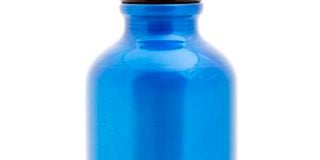How often do you clean your water bottle? It carries more bacteria than toilet seat

A reusable water bottle. Reusable bottles can harbour around 40,000 times more bacteria than the average toilet seat, a new study has found.
What you need to know:
- During the study published early this month, water treatment experts observed bacteria lurking in reusable water bottles.
- They discovered two types of bacteria: bacillus and gram-negative.Digestive tract complications such as diarrhoea, vomiting and nausea are among health issues linked to bacillus.
Reusable bottles can harbour around 40,000 times more bacteria than the average toilet seat, a new study has found.
Recyclable, eco- friendly water bottles have now been likened to a ‘portable petri dish following the study carried out by a team of American-based experts.
During the study published early this month, water treatment experts observed bacteria lurking in reusable water bottles.
They discovered two types of bacteria: bacillus and gram-negative. Digestive tract complications such as diarrhoea, vomiting and nausea are among health issues linked to bacillus.
On the other hand, several deadly infections including pneumonia can be triggered by gram-negative rods which include Klebsiella and E.Coli bacteria.
The researchers further investigated how four popular types of reusable water bottles harboured colony forming units (CFUs).
CFU refers to a unit commonly employed by scientists in estimating bacteria concentration in a sample being tested.
The findings indicated that at least 20.8million grammes of CFUs negative bacteria on average, were harboured inside reusable water bottles.
The highest level of CFUs contamination at 30 million was found on the bottle lid and spout. Compared to a toilet seat, which contains 515 grammes of CFUs negative bacteria, the number of bacteria inhabited in a water bottle is extremely high, the researchers observed.
Further, recyclable water bottles can house up to five million the amount of bacteria found on a computer mouse.
With a 1.48 million CFUs average, they account for 14 times the amount of bacteria on a pet bowl. Similarly, over 300,000 CFUs per centimetre squared were found on each water bottle among the 12 that were tested in a separate study conducted recently by researchers at America’s EmLab P&K.
Experts recommend washing reusable water bottles with hot water and soap everyday so as to eradicate bacteria build-up.
That said, there is limited evidence which shows that humans are endangered by the bacteria colonies harboured in reusable water bottles, according to experts. “A variety of bacteria colonies inhabit the mouth of human beings. The fact that drinking vessels are riddled with microbes is no surprise at all,” the microbiologists explain.
Apart from water bottles, a number of household items such as water taps are also covered with bacteria that are harmless.
“It is important to clean water bottles with hot water and soap. But merely bacteria presence is not necessarily dangerous,” the study reads.
“This study does not provide evidence that humans are endangered by the kinds of bacteria identified.”
“Water taps used at home are usually riddled with lots of bacteria whose effects are harmless to humans.”
Experts at the University of Reading explain that “it all depends on the type of bacteria involved to determine whether it will be a health hazard or not.”
“Large bacteria colonies are not necessarily a problem. They could be an alarm that an item has not been cleaned properly in a long time,” the scientists clarify.
“I have never heard of a water bottle making anyone ill. The same case applies to domestic water taps. They are not dangerous. Have you ever heard of anyone falling sick because of pouring tap water in a glass?”
According to the scientists, most bacteria already in human mouths are likely to be the ones contaminating water bottles.





